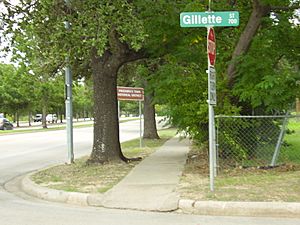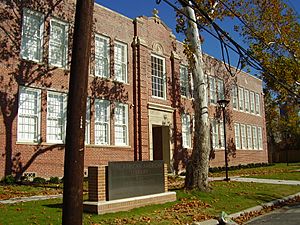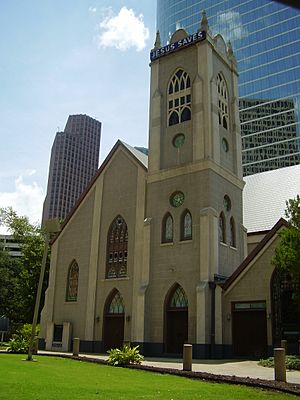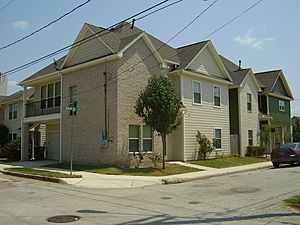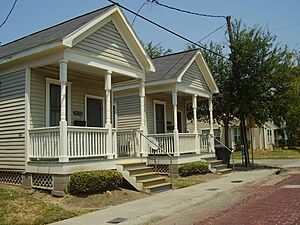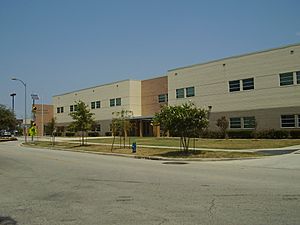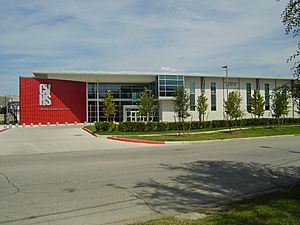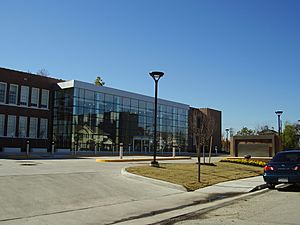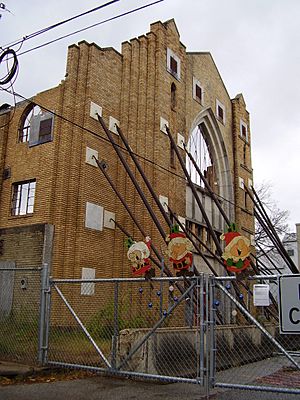Fourth Ward, Houston facts for kids
The Fourth Ward is one of Houston's original six neighborhoods, called "wards," in Texas, United States. It's located just west of Downtown Houston, inside the 610 Loop highway. The Fourth Ward is famous for being the home of Freedmen's Town. This was a special community built by African-Americans who had recently gained their freedom after the U.S. Civil War.
Contents
The Story of Fourth Ward
How Fourth Ward Began
The City of Houston created the Fourth Ward in 1839 as one of its first four districts. By 1906, this area covered much of what is now Downtown Houston and Neartown Houston. After that, the city stopped using the ward system.
This area became Freedmen's Town, a place for people who had been enslaved. In 1866, the first formerly enslaved people arrived in Houston from cotton farms along the Brazos River. They settled on the south side of the Buffalo Bayou, building small homes. They used simple outdoor shelters and borrowed churches for worship. More freed people soon joined them.
One of these shelters grew into the Antioch Missionary Baptist Church. Jack Yates, a very important community leader, became its pastor. He and his son, Rutherford Yates, helped lead the Fourth Ward in its early days. This neighborhood became the heart of Houston's African-American community in the late 1800s and early 1900s.
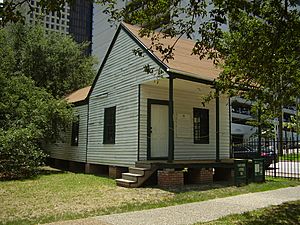
About 1,000 freed people chose this spot along the Buffalo Bayou because the land was cheap. White Americans didn't want it because it was swampy and often flooded. The settlers of Freedmen's Town made their own bricks by hand to pave the streets. People say that in the early 1900s, members of Reverend Jeremiah Smith's church paved Andrew Street with the first bricks after the city refused to help. Yates, Smith, and Ned P. Pullum were key ministers in the Fourth Ward.
The residents created their own services and businesses. They had blacksmiths, brickmakers, doctors, lawyers, and teachers. From 1905 to the 1940s, Freedmen's Town was home to West End Park. This was Houston's biggest baseball field until 1927. It hosted the Houston Buffaloes minor league team and was the first place in the city for Negro Major League games.
Around the turn of the century, Italian Americans also moved into the Fourth Ward. They opened small businesses and slowly bought more property. Many had given credit to customers and then took over property when debts weren't paid. Even in the year 2000, their families still owned many homes in the Fourth Ward.
As more families moved in, the neighborhood became very crowded. A report from 1984, based on old records, suggested that the crowded conditions and high rents might have led to a riot in 1917. In this event, African-American soldiers attacked White people. By the 1920s and 1930s, Freedmen's Town was almost six times more crowded than the rest of Houston. In the 1920s, the Third Ward became the new center of Houston's African-American community.
Changes Over Time
The Fourth Ward stopped growing because other developments surrounded it. Experts say the decline started around 1940. This was due to things like the opening of Interstate 45 and the building of Allen Parkway Village. Allen Parkway Village, a public housing complex, opened in the 1940s. It was first called San Felipe Courts and was only for White residents.
In the 1950s, Interstate 45 was built, cutting off the eastern part of the Fourth Ward. This area became the Allen Center business complex and is now part of Downtown Houston. The freeway also separated the community from Downtown itself. After the civil rights changes in the 1960s, many Black homeowners left the Fourth Ward, causing further decline. Freeway construction and city renewal projects led to parts of the community being lost.
New Beginnings
By the 1970s, many original Fourth Ward residents had moved away. Starting in the 1970s, the City of Houston wanted to tear down Allen Parkway Village, but residents fought to save it. Plans to replace the Fourth Ward with new homes and a park also began in that decade.
On January 17, 1985, Freedmen's Town was added to the National Register of Historic Places. This meant that federal money could no longer be used to tear down its historic buildings.
In the 1990s, a group called Houston Renaissance bought large parts of the community. They planned to build affordable housing. However, the group failed, and the Houston Housing Finance Corp. took over the land. The city then sold the land closest to Downtown to private builders. The money from these sales was used to build subsidized homes, costing around $110,000 each, on the remaining land.
The Houston Housing Authority voted to demolish Allen Parkway Village. This led residents to start a campaign to save the complex. The legal fight went all the way to the 5th U.S. Circuit Court of Appeals. In 1996, Henry Cisneros, who led the U.S. Department of Housing and Urban Development, agreed to let Houston tear down 677 of the 963 units. The condition was that the site still be used for low-income housing. The remaining old units were saved and put on the National Register of Historic Places.
In the late 1990s and 2000s, the area started to change with gentrification. Many new apartment buildings and fancy townhomes were built. Old "shotgun shacks" were torn down and replaced. Many long-time residents, who rented their homes, had to move because rising property values made rent too expensive. While lower-income renters left, wealthier homeowners moved in. Around the late 1990s, the Fourth Ward Redevelopment Corporation was created to help protect the community's history.
By 1999, the remaining parts of Allen Parkway Village were renamed The Historic Oaks of Allen Parkway. It had about 500 homes, with 280 old units and 220 new ones built with $30 million in federal funds. The first new residents were 156 low-income elderly people.
By 2004, parts of the Fourth Ward became part of the Midtown community. Apartments, restaurants, and townhouses replaced many old Fourth Ward landmarks. In 2007, the city offered to temporarily remove the historic bricks from some streets to fix underground pipes. They promised to put the bricks back. Some residents and history lovers didn't like this idea. The Houston Chronicle newspaper, however, thought it was a reasonable plan.
Who Lives in Fourth Ward?
The number of people living in the Fourth Ward has been going down for decades. In 2000, the Fourth Ward had the lowest population among Houston's "super neighborhoods," with 1,706 people in 590 homes. That year, 54% of residents were Hispanic, 37% were Black, 7% were White, and 2% were Asian.
By 2015, the super neighborhood had 4,085 residents. The population changed to 46% White, 27% Black, 18% Hispanic, and 9% Asian.
In 1870, 36% of Houston's African-Americans lived in the Fourth Ward. By 1910, this number dropped to 27%. While Freedmen's Town was traditionally Black, more Hispanic and White people have moved to the area recently. In 1990, 1,421 Black people lived in the Fourth Ward census area; by 2000, only 635 remained. The number of Hispanic residents grew from 750 in 1990 to 875 in 2000. White residents increased from 49 in 1990 to 180 in 2000.
In 1980, about half of the ward's residents lived below the poverty line, and 95% did not own their homes. The Fourth Ward had the poorest African-American community in Houston in the 1980s. In 2000, J. Don Boney said that Black people owned less than 5% of the land in the Fourth Ward, and much of that was owned by churches.
Fourth Ward's Look and Feel
Today, the Fourth Ward is west of Downtown Houston and stretches to Taft and Webster streets. It covers about 40 city blocks. The Downtown Houston skyline is less than a mile away. The Fourth Ward is also home to Houston's first city cemetery, Founders Memorial Cemetery. Allen Parkway Village covers 37 acres of land.
When the political district was ended in 1906, it reached south to Richmond Avenue and west to Montrose Boulevard. It included much of what is now Downtown. Its borders were Congress Avenue to the north, Main Street to the east, and the Rice University area to the south.
In 1984, a survey found 563 historic buildings in the community. When it was named a National Register of Historic Places site in 1985, it had 530 historic buildings on 64 acres. By 2007, community leaders said only 40 historic buildings remained. These were mainly between Arthur, Gennessee, West Dallas, and West Gray streets. Since 1984, over 500 historic buildings, including businesses, churches, and homes, have been torn down. By 2012, only 30 of the surveyed historic buildings were left. Of the 13 churches surveyed, six still stood in 2012.
Debbi Head from the Texas Historical Commission said that what makes Freedmen's Town special is not just one building, but how many old buildings are still together on the narrow streets. This shows what life was really like. During the Jim Crow era, Taft Street was a dividing line: Black families lived east of Taft, and White families lived west.
Homes in Fourth Ward
Houston is the largest city in the U.S. without zoning laws, which means there are fewer rules about what can be built where. This has led to traditional "shotgun houses" being mixed with tall buildings and parking lots. Sherry Thomas of USA Today said that this lack of building rules has changed the historical look of the Fourth Ward.
Most of the original homes were shotgun houses. These were long, skinny, one-story houses designed to let breezes flow through and keep them cool. Almost all had big front porches. The 1984 National Register application said these porches helped cool the houses and allowed people to talk to neighbors and watch children play in the streets. The report noted that the porch was often the only part of the house with any special design.
Because of new development, the eastern part of the Fourth Ward now has modern townhouses built by developers. Many of these townhouses have metal siding, and you can see Downtown Houston from them. Many young professionals and older adults whose children have moved out live in these townhouses. The area west of Buckner Street has many two-story suburban-style houses on small lots, built for lower-income families. By 2006, few shotgun houses remained. By 2007, the newer, subsidized homes cost $92,000, replacing most of the shotgun houses. The townhouses cost twice as much as the subsidized homes. Many long-time African-American residents couldn't afford to buy these new homes.
Victor Street Homes
As of 2007, the largest group of old homes still standing is on the south side of Victor Street. The north side of Victor Street has an apartment complex owned by the Houston Housing Authority. Victor Street has the only group of all-older houses left in the Fourth Ward. The ten shotgun houses at 1501 to 1519 Victor Street were built in two stages, some in 1914 and others between 1920 and 1922. Lisa Gray of the Houston Chronicle said they looked identical and were "nothing fancy, nothing special," but "just by surviving, they became special." These houses were listed on the National Historic Register of Historic Places and in the Houston Architectural Guide. However, city laws did not protect them from being torn down.
In April 2007, the owners asked the last residents to move out because the city said some houses had problems like poor upkeep and electrical issues. The last resident was set to leave in June. Jill Jewett, an assistant to Mayor of Houston Bill White, said the city wanted to save the Victor Street houses. Thuong Tran, a member of the family who owned the houses, hoped to lease them to a nonprofit that would fix them. She said her family planned to restore the houses but wasn't sure if they would stay there or be moved outside the 610 Loop. In 2011, the Harris County Appraisal District said the houses together were worth less than $750, while the land they sat on was worth over $500,000 more. The district called the houses an "economic misimprovement." That year, the owners, Kimsu and Kimberly Hoang, applied to tear down the ten houses.
Community Life
Mike Snyder of the Houston Chronicle said that "the politics of race have been a potent force in the Fourth Ward." In the 1920s, African-American renters complained about paying high rents for poorly kept buildings owned by white landlords. After a flood, an African-American newspaper blamed the city for neglecting the neighborhood. Jesse Jackson visited the Fourth Ward during his 1988 presidential campaign, saying the city was ignoring the community.
In 2007, David Ellison of the Houston Chronicle wrote that there was "some friction between new and longtime residents." Some long-time residents felt that the new developments only helped newcomers, not them. He noted that the two groups often lived separate lives. The New Fourth Ward Homeowners Association represents the owners of the newer subsidized houses. Its president, Christine Diaz, said the group is working to bring old and new residents together. Mayor of Houston Bill White also said he was trying to unite people by making improvements that most residents wanted.
Learning in Fourth Ward
Schools for Kids
Students in the Fourth Ward attend schools in the Houston Independent School District. These include Gregory-Lincoln Education Center for grades K-8 and Heights High School (formerly Reagan High School). Carnegie Vanguard High School, a special magnet high school, is also in the Fourth Ward.
For the 2006-2007 school year at Gregory-Lincoln, 68% of students were African-American, 31% Hispanic, and less than 1% White. Also, 94% of the school's 211 students qualified for free or reduced-price lunch. Houston Independent School District schools, like Gregory-Lincoln, spent about $5,558 per student in 2001-2002. This was less than the Texas state average of $6,850 and the U.S. average of $7,548 in 2002.
After Freedmen's Town was established, the Freedmen's Bureau opened schools for children. By 1870, the Texas Legislature allowed public schools to be created for Freedmen's Town. By 1872, most students and teachers from the closing bureau schools moved to the state-run Gregory Institute. This school was named after Edgar M. Gregory, a Union army officer and assistant commissioner of the Texas Freedmen's Bureau. The Gregory Institute, which opened in 1872, was the first school for freed slaves in Houston. Mike Snyder of the Houston Chronicle said it was "perhaps" the first such school in Texas. By 1876, the school became part of the Houston public school system.
The Edgar M. Gregory School, a 20,000 square foot elementary school building, opened in 1926. The community also had Lincoln Junior & Senior High School, which later became just Lincoln Junior High School. In 1980, the district closed the Gregory School and moved its students to Lincoln. Residents saw this as an attempt to weaken the Fourth Ward. The closing of Gregory was met with strong opposition from Fourth Ward residents. The Gregory School building was empty until it was turned into a library. When it was empty, it had broken windows, a leaky roof, and pigeons living inside. In 2009, it was reopened as a research library.
On March 21, 2002, the HISD board voted to buy a six-block area next to Gregory-Lincoln for a new school. This meant 70 families would be moved from their homes. Anthony Pizzitola, a homeowner, started a campaign against this, saying the district wanted valuable land more than a new school. In 2009, HISD suggested moving Carnegie Vanguard High School to the Fourth Ward. School leaders liked this idea because students come from all over the district, and a central location would make travel easier. The school board approved the plan that year.
Public Libraries
The Houston Public Library runs the African American Library at the Gregory School. This library keeps historical information about Houston's African-American community. It is the city's first library to focus on African-American history and culture.
Fun and Green Spaces
On March 25, 2009, the City of Houston bought the remains of the Bethel Missionary Baptist Church. This church was damaged in a fire in 2005. The city plans to turn the church ruins into a park. The city bought the church, one of Houston's oldest, for $350,000 using special tax money. The restoration project was planned to take two years. Before the city bought it, residents worried the ruins would be torn down for more townhouses. Since the fire, the Bethel Missionary Baptist Church congregation moved to a new building. Pastor Robert Robertson supported the city's plan to buy and restore the old church. The church was founded by Jack Yates.
The Rutherford B.H. Yates Museum Inc. owns six houses on ten lots as part of the Educational and Cultural Corridor Park. All of these are on the National Register of Historic Places. Three have State Historic Landmarks, four are protected city landmarks, and all have State Archaeological Trinomial registrations. These houses include the Rutherford B.H. Yates Sr. House, which was the home of Jack Yates's son. It is now the Yates Community Archaeology Lab and Yates Printing Museum. Most of these houses were designed by Black architects and built by Black contractors who were formerly enslaved people or their descendants.
The J. Vance Lewis homestead at Andrews and Wilson includes the 1907 J. Vance Lewis House, called "Van Court." Lewis, born around 1860, became an attorney. His wife, Pauline Gray-Lewis, was a teacher and librarian at the Carnegie Colored Library. A relative, Isabella Sims, lived at 1216 Wilson on the same property. The organization plans to turn the Lewis house into a Museum of Legal Professions & Educators.
A house at 1319 Andrews St., built in 1898, was the home of Reverend Ned P. Pullum and his wife, Emma. Rev. Pullum founded a brick yard that made 20,000 bricks a day, three pharmacies, and a shoe business. He also helped build a church and the first hospital for Black people, the Union Hospital. The organization plans to turn his house into a Health and Business museum. Antonio Tomasino Jr., a grocer, owned two buildings built by Black contractors: a shotgun house at 1514 Wilson and a workman's cottage at 1404 Victor. The 1514 Wilson house will become the site of the Archaeological Field School Lab. The 1404 Victor house, built around 1900, will become a Barber/Beauty Shop museum.
Fourth Ward in Movies
A White American filmmaker named James Blue directed a 1978 film called "Who Killed Fourth Ward?". Most of the filming happened in 1976, from July to September. You can find it on YouTube.
Famous People from Fourth Ward
- Jack Yates - His house was originally in the Fourth Ward. It was later moved to Sam Houston Park and opened to the public on December 11, 1996.
- Lenwood Johnson - An activist who worked to stop the demolition of Allen Parkway Village and later to protect the history of the Fourth Ward itself.
Images for kids


